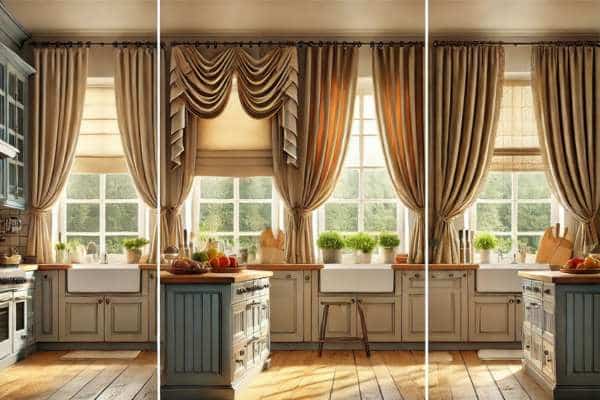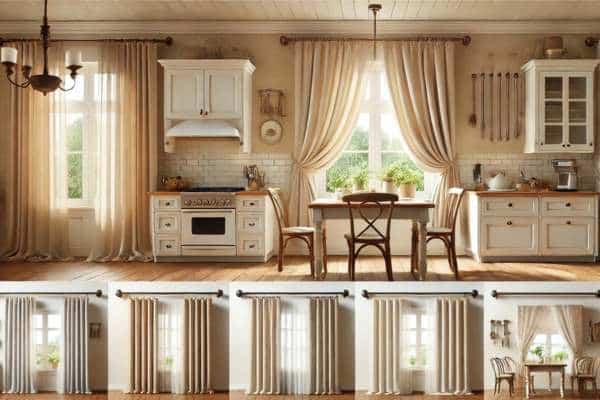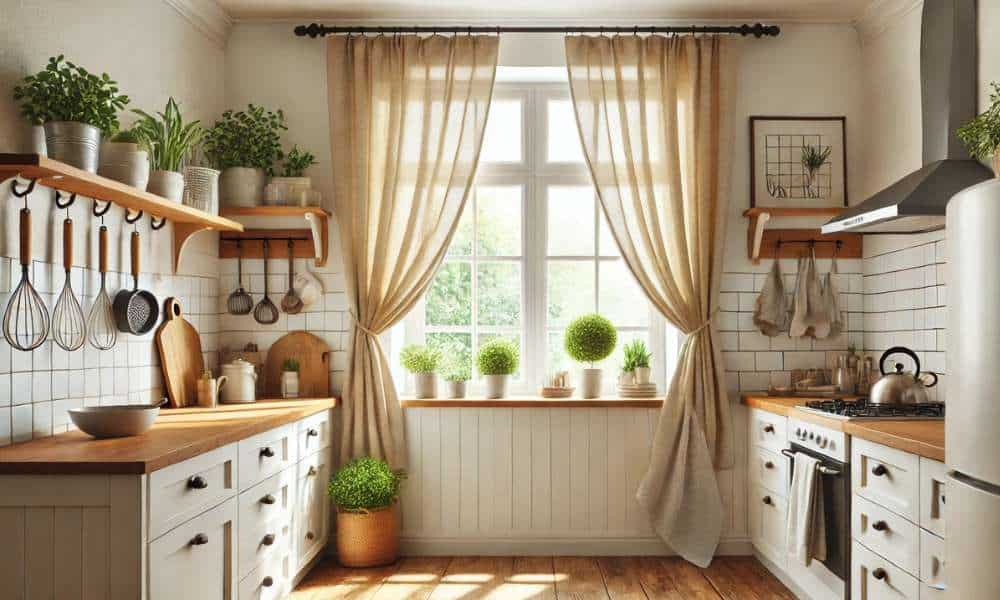Hanging kitchen curtains might seem simple, yet it’s a task that requires attention to detail for the perfect blend of style and function. Knowing how to hang kitchen curtains can elevate your kitchen’s look, adding warmth, privacy, and ambiance while also managing light. With various fabrics, styles, and curtain lengths available, selecting the right ones to match your kitchen’s layout is essential. In this manual, we’ll walk through the whole lot from selecting appropriate substances and curtain kinds to taking particular measurements and mounting hardware. Whether you’re aiming for a comfortable, rustic feel or a present day, streamlined look, these steps will assist you achieve a perfect end, transforming your kitchen into a stylish and functional area.
Understanding Kitchen Curtain Fabrics

The fabric choice for kitchen curtains is not merely a matter of looks; it directly influences the curtains’ resilience and functionality. Kitchens face unique challenges: humidity, temperature shifts, and the occasional splatter so choosing materials that can handle these demands is essential. Cotton and polyester blends are favorites due to their durability and ease of cleaning. For a gentler, airy look, voile and muslin bring a delicate touch, softly filtering light without sacrificing privacy. Linen, on the other hand, is timelessly elegant, though it requires mindful positioning, as moisture can easily affect it. Fabrics breathe life into curtains, so select with care.
Choosing The Right Curtains For Your Kitchen Space

Every kitchen has its distinct form and function. Curtains should enhance, not obstruct, the flow and feel of the room. For compact kitchens, light and breezy curtains that allow in ample light make the space feel open, while in expansive kitchens, heavier, more layered drapes can add a touch of sophistication. Think practically: curtains near sinks or stovetops should be short or firmly fastened with tiebacks to prevent contact with splashes or flames. For spaces with larger windows or breakfast nooks, full-length curtain foster a sense of warmth and relaxation.
Understanding Different Curtain Types For Kitchens

Not all kitchen curtain are alike. Different types serve unique purposes and aesthetics:
– Café Curtains: These charming half-length curtains cover the lower half of the window, providing privacy while welcoming light from above.
– Valances: Sitting proudly at the top, valances offer a dash of style and color without blocking light.
– Tiered Curtains: A mix of café curtain and valances, they layer the window in a way that’s especially suited to classic kitchen designs.
– Roman Shades: Clean, structured, and adjustable, Roman shades give kitchens a contemporary, uncluttered look.
Choose a style that matches the kitchen’s light, privacy needs, and overall vibe.
Picking The Right Curtain Length

Curtain length is crucial to defining the aesthetic of your kitchen. Cafe curtains generally cover just the lower portion of the window, stopping just above the sill, while valances fit snugly at the top. Full-length hang kitchen curtains may extend to the floor for a luxurious touch or stop right at the sill for a more functional look. Functionality also plays a role—short curtain work best near countertops to avoid contact with surfaces or accidental spills.
How To Measure For The Perfect Fit

Precision is key when measuring for curtains. Begin by measuring the width of your window and add a few extra inches on either side to allow the curtain to bunch nicely when drawn. For café curtains, measure from the middle of the window down to the bottom edge. Full-length curtain should be measured from the desired rod placement down to the floor or the sill, accounting for any curtain rings or hooks that may add length. The final look relies on getting these measurements right.
Selecting Curtain Colors And Patterns

The colors and patterns of your hang make kitchen curtains shape the entire kitchen ambiance. Light colors make small spaces feel expansive, while darker hues ground a larger kitchen with sophistication. Patterns, too, add personality: floral designs lend a vintage vibe, while geometric prints lean toward modernity. Consider your kitchen’s existing palette, and decide if you want the curtain to harmonize with or boldly contrast against the decor.
Types Of Curtain Rods For Kitchen Curtains
Curtain rods may seem like minor details, but they’re essential for function and style. Here’s a rundown:
– Basic Rods: Simple and effective, basic rods work well for lightweight curtain and budget-friendly installations.
– Tension Rods: Ideal for renters or small kitchens, tension rods are adjustable and require no drilling, making them easy to install and move.
– Decorative Rods: Available in various finishes, from brushed nickel to vintage brass, these rods elevate the look and work best for heavier or layered curtains.
Choosing Rods Based On Curtain Weight And Style

Choosing a rod that complements your hang kitchen curtains is crucial. Sheer, lightweight curtain work well with basic or tension rods, while heavier fabrics demand robust rods with supportive brackets. The style of the rod also matters—sleek rods blend seamlessly with contemporary designs, whereas ornate rods with intricate finials enhance traditional or farmhouse-style kitchens.
Prepping Your Space Before Hanging Curtains

Preparation is the unsung hero of an easy installation. Begin by clearing the area around the window for accessibility. Have your tools laid out and ready—measuring tape, drill, level, screws, and pencil marks for guidance. Wipe down the window area to ensure a clean surface, which prevents dust from adhering to fresh curtains.
Tools You’ll Need From Measuring Tape To Drill
Proper tools streamline the installation. Essential items include a measuring tape for accuracy, a level to ensure even placement, a drill for mounting brackets, and screws to secure them in place. For hard-to-reach windows, a step ladder is essential, while a pencil allows you to mark positions without permanent marks. With the right tools, you’re set up for a smooth process.
How To Measure For Curtain Rod Placement
Rod placement dramatically influences the visual height and width of your windows. Aiming 4-6 inches above the window frame adds the illusion of taller windows. Extending the rod 3-4 inches beyond the window width on each side allows the curtains to fully open without blocking natural light. These small adjustments give a polished look.
Step-By-Step Guide To Mounting Curtain Rods
1. Mark Rod Placement: Using your measurements, mark where the brackets will go. Make sure they’re equidistant from the window’s edges.
2. Drill Holes: Drill into the marked spots, keeping in mind the wall type for correct depth.
3. Install Brackets: Secure each bracket with screws, checking their alignment with a level.
4. Attach the Rod: Slide the rod into place and affix end caps if needed.
5. Add Curtain: Lastly, slide your curtains onto the rod and adjust them for an even, balanced appearance.
Hanging Different Types Of Kitchen Curtains
Each curtain style requires specific handling. Café curtains are easily mounted on tension rods, making them a great option for renters. Roman shades may need specialized mounts for smooth raising and lowering. For tiered curtain, ensure that the alignment between top and bottom tiers is perfect for a cohesive look. Valances, on the other hand, often require only a single rod and are primarily decorative.
Hanging Blackout Curtains For Kitchen Windows
For those who want privacy or need to manage direct sunlight, blackout curtains are an excellent choice. A sturdy rod is essential for supporting these heavier curtain. Hang blackout curtains slightly above and wider than the window frame for complete light control. These not only reduce glare but help regulate the kitchen’s temperature by blocking intense sunlight.
Adding Tiebacks And Holdbacks For Style And Functionality
Tiebacks and holdbacks are both practical and stylish. Tiebacks gather the curtains during the day, enhancing the natural light and giving the room an open feel. Decorative holdbacks, mounted on each side of the window, give curtain a tailored look, keeping them out of the way during kitchen tasks. Choose holdbacks or tie backs that harmonize with the curtain material for a refined appearance.
Maintenance Tips For Kitchen Curtains
To keep your kitchen curtains fresh and free from grime, regular cleaning is essential. Machine-washable fabrics make this easier, though delicate or embellished curtain may require hand-washing. Kitchens prone to smoke or grease benefit from a monthly washing routine. For small stains or spills, spot cleaning with mild detergent is effective, preserving the fabric’s color and texture.
Conclusion
Knowing how to hang kitchen curtains elevates your kitchen’s look and functionality. The right fabric, duration, and rod choice can beautify light management, privateness, and fashion, even as correct measurements and thoughtful placement add a sophisticated finish. With easy tools and a few steps, you may transform your kitchen area, making it more welcoming and aligned along with your decor. From selecting an appropriate curtain type to keeping a smooth, sparkling appearance, each element contributes to a kitchen that’s as realistic as it is lovely. Thoughtfully hung curtain bring a touch of warmth and character, completing the ambiance of your kitchen effortlessly.

